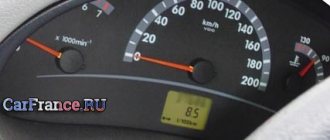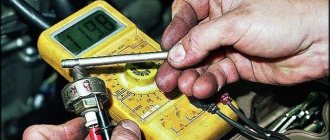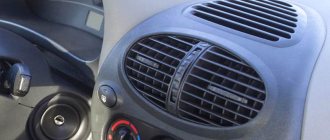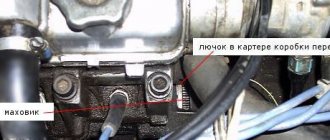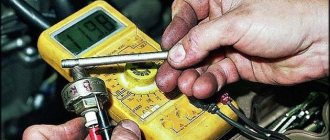Greetings to the owners of domestic VAZ "ten", as well as to all those who are now reading these lines! In previous issues we talked a lot about foreign cars (Mitsubishi Lancer 9, Renault Duster, VW Polo sedan, etc.), it’s time to devote a couple of pages to those who support the Russian automobile industry. So, we will talk about the topic: what to do if the fuel consumption of the VAZ 2110 has increased, as well as what it should actually be with proper operation.
Main reasons for increased fuel consumption
There may be many reasons why fuel consumption has increased.
Let's look at the most common ones. This phenomenon may indicate dishonesty at the gas station. At gas stations they try to deceive us: they don’t add gasoline, they sell low-quality fuel through the use of additives, sometimes they simply dilute it with water. The first thing you need to do is change the gas station. If the consumption is still high, then it is necessary to take compression measurements in the cylinders. There is a direct relationship between engine power and compression: if one indicator decreases, then the other decreases as well. Accordingly, in order to achieve the same dynamics, you need to press the trigger harder, which leads to high gasoline consumption. Compression can decrease for various reasons: leaky valve seal to the seats, loss of mobility of the piston rings, wear of car engine components. The wear of the cylinder-piston system can be determined using a corrected air flow sensor. It is enough to compare its current reading with the standard for a specific electronic control unit. If the resulting value is less, this indicates wear and tear on the system. Moreover, the more the indicator differs from the standard, the higher the wear. When coking the piston rings, the engine does not need to be disassembled. It is enough to use decoking agents. Next, you should evaluate the condition of the spark plugs. Black carbon deposits on them indicate an enriched fuel mixture. It does not burn completely, its remains fly out into the pipe, so high fuel consumption occurs on the VAZ 2110 injector, the reasons for which are related to filter clogging, improper operation of the mass air flow sensor and the air pressure sensor. The over-enrichment of the fuel mixture in an injection engine is influenced by the thermostat. If its valve opens earlier than necessary, the engine does not warm up to operating temperature. The electronic control unit will react in a timely manner - it will begin to supply the enriched mixture. The reasons for over-enrichment of fuel for a carburetor engine are related to its incorrect adjustment or clogged filter. Light soot indicates that the fuel mixture is “poor”. When working on it, engine power decreases. In this case, gasoline consumption increased due to: malfunctions or incorrect engine adjustments - for carburetors; low pressure in the fuel line, malfunctions of the mass air flow sensor and diesel fuel sensor - for injectors. Low pressure in the fuel line indicates a clogged fuel filter or worn fuel pump. Increased fuel consumption on a VAZ 2110 (8-valve injector) may be caused by other faults in the fuel system. For example: malfunction of the fuel return valve, clogged injectors (they do not spray fuel well, so the fuel mixture is of poor quality). If fuel consumption increases during the cold season, then this is normal. The load on the engine increases. It takes more time to warm up the engine, which also cools down very quickly. Additional energy is required to heat the interior even in the realities of driving on ice and snow (slippage, etc.). The engine suffers loads due to the viscosity of the oil in the gearbox and the grease in the bearings. Of course, gasoline consumption in winter is higher than in the warm season. This difference is subtle, but sometimes it can make a shocking difference. For example: fuel consumption on a VAZ 2110 1.5 injector when operating over long distances in winter can be increased by only a few liters. At the same time, consumption when driving short distances on a snowy road can increase by 2 times. High fuel consumption on the VAZ 2110 8-valve injector may be associated with driving style. So with constant acceleration and braking, the indicator increases. It is also influenced by: the quality of rubber, the absence of flat tires, an increase in the weight of the vehicle due to its improvement (tuning accessories, installation of large speakers). The load on the motor may be excessive due to incorrect wheel angle setting. Timely identification of the cause of increased fuel consumption will save your budget and prevent deterioration in vehicle performance.
Varieties
This car model has gone through several modifications and this has affected the internal engine systems, some external design details and fuel consumption figures.
1.5i (79 hp petrol) 5-mech
1.6 (80 hp petrol) 5-mech
1.6i (89 hp, 131 Nm, petrol) 5-mech
1.5i (92 hp, petrol) 5-mech
| Engine | Consumption (highway) | Consumption (city) | Consumption (mixed cycle) |
| 1.5 (72 l. petrol) 5-mech | 5.5 l/100 km | 9.1 l/100 km | 7.6 l/100 km |
| 5.3 l/100 km | 8.6 l/100 km | 7.2 l/100 km | |
| 6 l/100 km | 10 l/100 km | 7.5 l/100 km | |
| 6.3 l/100 km | 10.1 l/100 km | 7.7 l/100 km | |
| 7.1 l/100 km | 9.5 l/100 km | 8.1 l/100 km |
There are different types of VAZs:
:
- 8-valve with 1.5 l engine (carburetor);
- 8-valve injector with 1.5 engine;
- 16-valve 1.5 engine injector;
- 8-valve 1.6 l engine injector;
- 16-valve engine with a volume of 1.6 liters and injector.
Each version of the VAZ has its own advantages and disadvantages, especially regarding fuel consumption. But after the release of cars with a different fuel supply system, the weaknesses of the first VAZ model became clearly visible. One of them is the fuel consumption of the 2110 injector, which has decreased significantly due to this modification of the fuel system.
High gas consumption of VAZ 2110 and all about it
Today, high gas consumption of the VAZ 2110 is a fairly common problem among car owners. High gasoline consumption for a VAZ 2110 can occur for various reasons. However, before you “treat” the car, it is worth finding what is causing the car to function poorly. Indeed, if a car begins to overuse fuel, then this is bad, as undesirable consequences may appear.
Disadvantages of the VAZ 2110 car
VAZ 2110 high fuel consumption
VAZ 2110 is a sedan with four doors. The peculiarity of the car is its original and unusual design. The production of this brand was first discussed in 1996. It is still being created today. The car is in high demand due to the fact that:
- They are made of quality materials;
- They can overcome any obstacles;
- They cope with any trails and conditions.
Note: By the way, they say that the amount of fuel it consumes also depends on the roads on which the VAZ 2110 travels. Therefore, sometimes it is impossible to deal with the problem of high gasoline consumption of the VAZ 2110.
Today the car is manufactured under the Bogdan 2110 brand in Ukraine. The VAZ 2110 was initially produced in several modifications. The engine is a four-cylinder, runs on gasoline, and has a volume of 1596 cc. Because of this, the car reaches speeds of up to 180 km/h.
VAZ 2110 what is the gas consumption
The downside of the car is its high fuel consumption. Of course, this drawback also occurs in other cars. Additionally, it can be fixed. However, first you need to know the factors that contributed to the emergence of this discrepancy. As noted earlier, they are different and there are a lot of them. Therefore, it is better to understand everything thoroughly or take the car to a car service center.
Reasons for high fuel consumption
VAZ 2110 gas consumption is high
Since the driver has decided to repair the car himself, the reasons for the expense may be as follows:
- Reason 1 - off-road. So, if a motorist lives in a village or rural area, then you should not hope that his car will “eat little fuel.” When driving off-road, a huge load is placed on the car, so it cannot function properly. In this case, it is not worth bothering the car with repairs. Perhaps it will drive better, but it is unlikely to consume less fuel. Of course, there is a way out: you need to move to the city.
VAZ 2110 gas consumption is high
Note: if a motorist likes to drive short distances (say, to and from the store), then he will also have a problem with fuel. The car starts, wasting fuel. When it stops, gasoline is also consumed. The result is a large amount of wasted gasoline. Low speeds are also not the best option. If a beginner is just learning to drive, then he should choose cars that consume very little fuel.
- Reason 2 - sensors. This is a common reason why modern cars start using more fuel than necessary. The pressure problem occurs due to improper operation of the sensors that calculate the normal volume of the air-fuel mixture.
These include:
- Temperature sensors that cool the liquid if necessary;
- TPDZ;
- DMRV;
- Oxygen sensor.
VAZ 2110 increased gasoline consumption
Note: If at least one of these sensors is faulty, the mixture may turn out to be too “lean” or “rich”, which will lead to high gasoline consumption of the VAZ 2110. You can talk about this malfunction only after diagnosing the car. However, it is possible to determine the presence of this problem using the sensor overhaul method.
- Reason 3 – fuel system pressure. In this case, an increase in pressure is quite rare, while a decrease is very common. Eventually, the engine's power (see How to Repair an Engine Properly) decreases, so it runs longer to keep the car running properly. As a result, high gasoline consumption of the VAZ 2110 is observed.
Model characteristics
VAZs of this class have the same fuel consumption data and technical information as the original version of the car. Sometimes they increase due to the presence of different types of engines - by the number of valves and engine volume.
The 8-valve model with a 1.5 liter engine has a power of 76 hp. s., develops a maximum speed of up to 176 km/h, and accelerates to 100 km in 14 seconds.
This version of the VAZ differs from its predecessor in the presence of spark plugs and an air filter, as well as acceptable fuel consumption.
16-valve injector of the same volume with a power of 93 hp. has a maximum speed of 180 km/h,
and acceleration is carried out in only 12.5 seconds. But these improvements did not in any way affect the gasoline consumption of the VAZ 2110 injector, since its performance did not decrease at all.
The 8-valve model with a 1.6-liter engine has a power of 82 hp. s., maximum speed – 170 km/h
and at the same time accelerates to 100 km in 13.5 seconds. These characteristics slightly reduce fuel consumption compared to previous models.
VAZ with 16 valves of the same engine volume and 89 hp. has a maximum speed of 185 km/h and acceleration to 100 km in 12 seconds.
VAZ 2110 high fuel consumption
Lada VAZ-2110 (2111, 2112). Increased fuel consumption
| List of possible faults | Diagnostics | Elimination methods |
| The air filter element is clogged | Check the condition of the air filter replacement element | Blow or replace the air filter element |
| Leaking power system | Smell of gasoline, fuel leaks | Check the tightness of the connections of the fuel system elements; If a malfunction is detected, replace the corresponding components |
| Spark plugs are faulty: current leakage through cracks in the insulator or carbon deposits on the heat cone, poor contact of the central electrode | Spark plugs are checked on a special stand at a service station. The absence of external damage and sparking between the electrodes on the inverted spark plug does not allow us to draw a conclusion about its functionality | Replace spark plugs |
| Throttle actuator malfunction | Check the travel of the gas pedal, the clearance in the drive (free play of the pedal), make sure that the cable and pedal are not jammed | Replace faulty parts, lubricate the cable with engine oil |
| The idle speed controller or its circuits are faulty | Replace the regulator with a known good one. | Replace the faulty regulator |
| The throttle valve does not close completely | The gap between the throttle valve and the walls of the housing is visible in the light | Replace the throttle assembly |
| Increased pressure in the fuel line due to a faulty pressure regulator | Check the pressure in the fuel system with a pressure gauge (no more than 3.5 bar) | Replace the faulty regulator |
| Leaking injectors | Check the injectors | Replace faulty injectors |
| The coolant temperature sensor or its circuit is faulty | Check the sensor resistance with an ohmmeter at different temperatures | Restore contact in electrical circuits, replace the faulty sensor |
| The oxygen concentration sensor is faulty | You can evaluate the performance of the oxygen concentration sensor and the reliability of its electrical circuit connections using diagnostic equipment at a service station | Restore damaged electrical circuits, replace faulty sensor |
| The ECU or its circuits are faulty | To check, replace the ECU with a known good one. | Replace the faulty ECU, restore damaged electrical circuits |
| Low compression in the engine cylinders (less than 11.0 bar): clearances in the drive are not adjusted, wear or damage to the valves, their guides and seats, stuck or broken piston rings | Check compression | Adjust the clearances in the valve drive. Replace faulty parts |
| The throttle position sensor, absolute pressure and air temperature sensors in the intake manifold or their circuits are faulty | Check the sensors and their circuits | Restore contact in the electrical circuits, replace the faulty sensor(s) |
| Increased resistance to gas movement in the exhaust system | Inspect the exhaust system for dented or damaged pipes, check the condition of the catalytic converter | Replace damaged exhaust system components |
| Malfunctions of the chassis and brake system | Check the chassis and brake system | Adjust the wheel alignment angles, replace faulty chassis parts, and troubleshoot the brake system. |
Reasons for high fuel consumption
There are several common mistakes that inexperienced drivers make that lead to excessive fuel consumption. Remember that excess gasoline or diesel fuel will be consumed when:
The operation of the air conditioner or climate control system. The operation of these devices is related to the operation of the compressor. After all, to rotate the pump pulley, energy is required, which is taken from the rotating crankshaft. And it requires additional fuel. The operation of the heating system. This applies not only to the operation of the “stove”, but also to heated seats, windows and mirrors (in cars where these options are provided). The logic here is similar to the situation described above. Sharp acceleration. If you like to pull away quickly at traffic lights or other places, then be prepared for the fact that your car will consume more fuel than usual. This is due to the fact that any transient process (in this case, setting the machine in motion) is associated with increased energy consumption. And the sharper it is, the more energy is needed. Therefore, try to move off smoothly. This way you will not only save fuel, but also save tires, clutch and power unit components. Engine running at high speeds. Try not to over-gas. This will not only save fuel for your car, but will also have a positive effect on the overall performance of the engine. Using low-quality fuel. Try to refuel at trusted gas stations and fill the tank with the brand of fuel recommended by the car manufacturer. After all, bad fuel burns worse, provides insufficient energy and requires additional energy consumption.
Technical reasons for increased fuel consumption
First, let's look at the technical problems that contribute to increased gas mileage in a car. Let's find out the most common reasons related to the engine and other elements that increase consumption.
Engine wear
Usually occurs due to high mileage of the car or due to improper use. Some points related to engine operation:
- coolant (coolant) temperature is lower than calculated; - wear of the cylinder-piston group; - wear of the crank mechanism; - wear of the gas distribution mechanism and unadjusted valve clearances.
Clutch wear
When the driver needs to keep high revs in order to get off the road and switch to a higher gear, this directly affects fuel consumption. In this case, replacing the clutch will help.
One of the reasons for increased fuel consumption is clutch disc wear. The situation here is quite simple. During the starting process, the engine consumes more fuel than at constant speed. This fact is present even with a working clutch. If the disk or other parts of the system are faulty, then it turns out that fuel is consumed, and the car stands still. The more often the car starts moving, the greater the excess fuel consumption occurs.
Elimination methods
The mass air flow sensor (MAF) is considered a target device for detecting fuel loss. A machine with the sensor disabled may perform well. This agility is the beginning of the end of the mass air flow sensor. The device is turned out and the voltage is checked with a tester (the ignition is on).
Checking the mass air flow sensor
Based on the individuality of each car, the voltage should not exceed 1.03 V. Otherwise, the sensor is replaced. A VAZ-2110 with a volume of 1.6 liters and a speed of, for example, 2000 requires about 25 kg of air. Therefore, as this value increases, gasoline consumption increases. Hence the priority of diagnosing the air flow sensor.
- A faulty fuel system simultaneously increases the level of harmful emissions into the atmosphere, reduces power, and turns off the engine when idling. The situation requires checking the fuel pressure supplied to the injectors using a pressure gauge (preferably with a 7-fold division range).
Measuring fuel pressure
Overspending is accompanied by:
- Coolant temperature . A defect in this sensor results in a “lean” or “rich” fuel mixture.
- A malfunctioning throttle clamp sensor directly affects the idle speed and throttle response of the vehicle.
The throttle position sensor affects the engine idle speed
Excessive fuel consumption is accompanied by a malfunction of the ignition coil
Excessive fuel consumption depends on many factors, such as timely repairs and vehicle maintenance.
Reasons for increased fuel consumption on the injector
in Engine 11/01/2017 13,
Cars equipped with electronic fuel supply through an injector rightfully have lower fuel consumption than carburetor engines. There are times when, at first glance, an absolutely serviceable car consumes quite a lot of fuel.
We measure fuel consumption on an injection engine
Before taking measures to find problems associated with increased consumption, you first need to measure fuel consumption. This process is not complicated.
Fill up your car, reset the odometer to zero, and continue driving. Try to drive the car quite calmly, without making sudden maneuvers, then the odometer will show fairly accurate fuel consumption readings.
Now knowing exactly how much fuel you filled at your last refueling, divide the amount of fuel used by the kilometers traveled and multiply by one hundred. After which you will have the result of fuel consumption, and determine the fuel consumption with minimal errors. This will allow you to understand whether the problem with high fuel consumption is worth solving, or whether the injector is fine and your car is consuming the right amount of fuel.
Reasons for increased fuel mixture consumption
The most common cause of increased fuel consumption is the failure of sensors that transmit incorrect information to the ECU.
Sensor failure
The main sensors installed on injection engines and the reasons for their failure. — Throttle position sensor. When the factory settings of this sensor are lost, it increases the idle speed. In addition, this leads to an erroneous ignition timing and an incorrect composition of the combustible mixture and air supplied to the fuel system. All this leads to increased consumption.
Adjusting the XX mode
Many experts agree that idle speed control is very important for injection systems. In particular, this will eliminate the floating speed, its spontaneous increase or decrease, which will ultimately normalize fuel consumption. As a rule, problems with engine speed in idle mode arise due to excessive air intake. The regulator’s task is to check the regulator, or make changes to the computer, which takes into account the readings of a number of sensors and opens the valve for a certain time, or check the sensors themselves.
This is how the XX adjustment is usually carried out. To begin with, the car's power supply system is de-energized. Then work is carried out with the regulator, which is embedded in the throttle. It is he who is responsible for uniform heating and stable operation of the engine. This is an electric motor with a needle that produces the recommended amount of incoming air, without turning on the throttle.
- The regulator is removed by unscrewing the mounting screws. The latter may not be removable. In this case, you won’t be able to unscrew them; you will have to remove the throttle body.
- Next, the regulator’s tasks include cleaning the regulator channel. It can be washed and then thoroughly blown with compressed air.
- Then you need to disassemble the regulator to get to the guide sleeve.
It is important to know that the regulator should be disassembled extremely carefully. Accuracy is needed primarily because of the sensitive winding of the regulator. It can be easily damaged.
Next you need to do the following.
- Check how the cone needle rotates. If it is loose, then this means only one thing - the bushing needs to be replaced, as there is play. In addition, the cone needle should not show signs of damage or abrasion.
- Then you need to test the integrity of the pressure spring.
- You need to check the contacts and integrity of the winding.
- After assembling the regulator, it must be installed on the car, but before that, measure the distance to the needle. The length should be exactly 23 mm.
- After installing the regulator, you need to connect the control plug to it, and then turn on the power. Having started the engine, you can analyze its functioning at idle and in other modes.
| Adjustable zones | Purpose | What can be achieved |
| Throttle sensor | The throttle position sensor is used to open the throttle and transmit control information to the electronic engine control unit. The sensor is usually installed opposite the throttle control lever. Periodically, the throttle sensor needs to be checked and adjusted accordingly. | Increased engine efficiency, reduced fuel consumption. |
| Ignition system | Ordinary. | Eliminate starting problems, reduce fuel consumption. |
| Suction | Restricts the flow of air into the fuel mixture, causing it to become richer. This is necessary to start a cold engine and its subsequent uninterrupted operation until the temperature becomes optimal for normal operation. Then the engine no longer requires such a rich mixture, and it can operate on a working idle system. The suction regulator is located on the panel in the cabin and is a round flat handle. | Emissions are improved and fuel consumption is reduced. |
Forget about fines from cameras! An absolutely legal new product - Traffic Police Camera Jammer, hides your license plates from the cameras that are installed in all cities. More details at the link.
- Absolutely legal (Article 12.2);
- Hides from photo and video recording;
- Suitable for all cars;
- Works through the cigarette lighter connector;
- Does not cause interference to radios and cell phones.
Topic: VAZ-2110 high consumption
Theme Options
- print version
- Subscribe to this topic...
VAZ-2110 high consumption
Good evening. Help me figure it out, please. We have a VAZ-2110 ECU was Bosch M1.5.4, replaced with January 5.1.1 due to flooding. The problem is the prohibitive CO 6.5% compression 11-10.5-10.5-10.5, the injectors were replaced with new ones, there are no leaks. The module, spark plugs, wires have been checked and replaced. Everything works, but nothing changes. Parameters from the scanner are attached.657.jpg
Re: VAZ-2110 high consumption
what year? Is oxygen on the exhaust? I think the block will have to be flashed to your specifications.
Re: VAZ-2110 high consumption
I don’t remember what year, there is no oxygen supply at the outlet, the standard is R-83. When replacing the block, I filled in J5V13I02. However, such an injection time, where does 6.5% CO come from?
Re: VAZ-2110 high consumption
Was the CO regulated? Manually Or have you already hit the -25% limiter and the mixture is still rich?
How alive is the mass air flow sensor? Isn't a sports RDT worth it?
Re: VAZ-2110 high consumption
[quote="FOX1062;912757"]Attached are the parameters from the scanner[/quote
You're doing great in electronics! Look at the performance of the injectors, with such air 7.5 kg and CO-0.25, and an injection time of 1.5 ms, it should stall.
Re: VAZ-2110 high consumption
However, it doesn't stall. The adjustments were already stuck, I installed a new MAF, with the old one it showed 10.5 kg, the injection was 2.5, CO reached 12%, and the injectors are also new. From the available ones I chose the one with the minimum performance.
Re: VAZ-2110 high consumption
Perhaps their performance does not match. You can adjust their performance in the firmware, or change the cyclic filling correction.
About the mass air flow sensor: New doesn’t mean it’s working, does it work on another car? voltage at rest?
Re: VAZ-2110 high consumption
What color are they, green? I want to say that the problem is definitely only in the injectors!! Your old mass air flow sensor works too! 10-11kg is normal. I also remember that the pressure regulator sucked in gasoline through a vacuum hose! And further ! Check the pressure, sometimes the return line is pinched and the pressure is too high. If not, then definitely the injectors.
Look at the photo! Scanmatic shows all the ideal parameters!
You speak correctly and competently! But the total is 1.6 m.s. Where less? In general, look at the scanmatic (photo)
Influence of time of year, temperature and sensor serviceability
Again, a lot depends on the time of year. In winter, every vehicle uses much more fuel. This is due to the long warm-up of the engine, the condition of the road surface, and periodic slipping. In the summer months, the basic consumption rate decreases if you do not keep the windows open when driving at high speeds.
Another reason has to do with the functioning of the sensors. If they are set incorrectly, they will not be able to correctly calculate the sufficient volume of the air-fuel mixture, as required by the engine control unit. This is an oxygen sensor, an air metering sensor and others. As a result, an overly enriched mixture begins to form, which empties the tank in a short time.
The first cars in this series have a carburetor engine, which can be manually adjusted to reduce fuel consumption. It will not be possible to set up an injection engine in the same way. However, it is periodically necessary to look into the injectors of the power unit and check whether they are clogged. If clogged, they begin to spray more gasoline, while the quality of the working mixture remains low.
It is known that the normal temperature of the power unit should be in the range of 90–100 degrees Celsius. As soon as it starts to overheat, the mixture becomes unnecessarily discharged. Engine power immediately drops, which leads to excessive fuel consumption. There is also the concept of “instant fuel consumption,” which is reflected on the trip computer screen. But unfortunately, not all cars are equipped with it. This indicator is influenced by the speed of movement and engine speed. In some cases, it can amount to tens of liters per hundred kilometers, but you should not be afraid of this, since we are talking only about the every second value when accelerating the car in low gears.
With this we will say goodbye. Subscribe to blog updates to continue receiving interesting newsletters. See you again, dear car enthusiasts!
Why does the VAZ-2110 have high gas consumption: reasons for increased fuel consumption
Driving speed, relief, climatic, temperature conditions, quality of gasoline, driving style, engine condition, running faults, improperly inflated tires, braking system, non-standard wheel radius and other factors can increase fuel consumption.
Why does the consumption exceed the passport values?
Consumption exceeding the passport figures is fraught with reasons, often interrelated. This automobile disease can be identified by diagnosing its operational parameters, technical condition, and external factors:
- Dark exhaust, loud pops from the muffler.
Based on 100 km of travel, additional losses are also tied to engine displacement and the number of valves.
Sequence of diagnostic work
Before intending to bring consumption to factory values, it is advisable to narrow the range of reasons, starting with electronic, fuel systems, sensors, filters.
The sequence of inspection stages for the VAZ-2110 includes:
- Removing and cleaning the fuel pump diaphragm.
Clean the fuel pump diaphragm and change the mesh
Cleaning the injector nozzles
Adjusting the thermal clearance of the valves
Checking the speed device
Changing the oxygen sensor
Engines with different numbers of valves
Let's start with the fact that the consumption rate will be different for different types of engines, which differ in the number of valves and design features. The first tenth Lada was equipped with a 1.5 carburetor engine producing 72 hp. This modification was produced for a relatively short time, only 3 years (1996–1999).
Next, it’s time for injection engines. First, let's look at the 8-valve power unit. This engine could not boast of special dynamics and power of 76 hp. for volume 1.5 and 81 hp. for later 1.6. But fuel consumption in the city was slightly higher than 9 liters, and outside it dropped to 5.5 liters per 100 km.
The 16-valve engine was structurally new for the giant plant and, in a sense, revolutionary. Its volume could be 1.5 or 1.6 liters, with the former being more powerful. The average gasoline consumption in both cases is approximately the same - 7.2 - 7.3 liters (at least, this is what the manufacturer declares). At the same time, in the city it takes up to 9 liters, and on the highway some 5.5 liters.
| Engine, modification | Fuel consumption in the urban cycle, l/100km | Fuel consumption in the extra-urban cycle, l/100km | Fuel consumption in the combined cycle, l/100km |
| 2110 1.5 (72 hp) 8 valves, carburetor | 9,1 | 5,5 | 7,6 |
| 21101 1.6 (81 hp) 8 valves, injector | 7,5 | 5,3 | 7,2 |
| 21102 1.5 (78 hp) 8 valves, injector | 8,6 | 5,3 | 7,2 |
| 21103 1.5 (94 hp) 16 valves, injector | 8,8 | 5,5 | 7,2 |
| 21104 1.6 (89 hp) 16 valves, injector | 7,7 | 5,5 | 7,2 |
| 21106 engine OPEL 2.0 (148 hp) 16 valves, injector | 9,8 | 5,4 | 7,1 |
The fuel consumption of the VAZ 2112 hatchback will be almost the same, and the VAZ 2111 station wagon with the same power units is 0.1–0.3 liters per 100 km higher.
Replacement process
Replacing the coolant temperature sensor VAZ 2110
To check and replace the temperature device, you will need the following tools and materials:
- Socket wrench set to “19”;
- Sealant;
- Coolant;
- Copper washer.
Note. The temperature sensor is located in the VAZ 2110, often in the intake manifold near the thermostat housing, rarely in the cylinder head. It is installed so that the tip comes into contact with the coolant. Only in such cases is his signal correct. If the coolant level is low, the sensor readings may be incorrect.
Idle speed control
Today, in urban environments, drivers simply cannot do without idling. Therefore, every car, including the VAZ 2110, is equipped with an idle speed sensor. Incorrect operation or failure of this regulator will significantly complicate driving, because it will cause the engine to stop even during the shortest stops. So if the controller fails, and this is not uncommon in VAZ 2110 cars, it needs to be changed as quickly as possible.
Removing the idle air control
The main purpose of this type of regulator is to support the speed required for normal operation of the power unit. Thanks to the device, the driver can always make a short stop as a result of changing the incoming air volume. As for the location, this controller is installed on the throttle line. In particular, we are talking about an anchor stepper motor, which is equipped with two windings.
When a corresponding signal is received on one of the windings, a special needle moves forward one step and backwards one step. Thanks to the worm gear, the device rotates, which is produced using a stepper motor, thus converting this movement into translational. The rod itself, namely its conical part, is located in the line through which the air flow is supplied.
Thanks to the functioning of the rod, the system adjusts the idle speed of the power unit. The rod from the device, as mentioned above, can be retracted or extended. In this case, it all depends on what kind of pulse will be supplied from the regulator. The controller itself allows you to adjust the frequency at which the engine crankshaft will rotate when the machine is stopped for a short time.
In addition, the controller controls the incoming air flow, which bypasses the throttle in the closed position. When the engine is warmed up, the regulator, by controlling the movement of the rod itself, at idle speed allows you to maintain the required crankshaft speed. In this case, the load and condition of the power unit do not play a role.
It is usually quite difficult for the average driver to explain the intricacies of the calculation being carried out.
If you like to pull away quickly at traffic lights or other places, then be prepared for the fact that your car will consume more fuel than usual. If high gasoline consumption is due to slight wear or coking of the piston rings, the situation will be improved by using a special additive in Suprotek Active Plus or Suprotek Active Standard engine oil.
Air regulator
The ECM is the electronic engine control system. And she needs to know how much air to supply for the amount of fuel supplied. These two parameters are closely interrelated because they allow you to create an optimal air-fuel mixture.
Having determined the amount of air, the system determines the required volume of gasoline. The air sensor is responsible for the suction volumes. The disadvantages of this device include:
- Due to exposure to moisture, performance is impaired;
- At low speeds, the sensor produces increased readings;
- The device cannot operate normally when idling;
- Problems may arise when starting the engine;
- After increased power mode, the engine may stop abruptly;
- Fuel consumption increases.
How does this sensor work? Let's try to figure it out.
- The regulator design includes three sensitive components that are installed in the air flow. One of the elements determines the temperature of the intake air, and the other two heat up to the required levels.
- Air flow is determined by measuring the power of electricity to maintain the required temperature.
- The regulator has a mesh that is mounted in the air flow.
- All this allows you to transfer information to controllers, which, in turn, enable certain modes to change or maintain loads.
Article on the topic: Technical features of the VAZ 2114
Piston system and internal modifications
People who are involved in motor sports have not stopped at engine tuning in the form of installing a turbine and reflashing it to new parameters. They need reliability, speed and incredible dynamics, so they additionally make changes to the piston system, seriously changing the very system of existence of the power unit. Boring the cylinder block on a VAZ 2110 is possible, but on later Lada models it is excluded. Today the plant saves on engines, spending less metal on their production. So, another way to tune the “Ten” is to do the following:
- search and purchase of wider pistons, which may not be made by VAZ;
- complete with pistons, you will have to replace the connecting rods, valve system and other parts of your car’s engine;
- disassembling the engine, boring the cylinder block and installing new purchased parts into the power unit;
- engine assembly, installation of a new fuel supply system, installation of a turbine and other equipment;
- It is necessary to reflash the computer, since all technical properties of the engine have been changed;
- addition of new technical units and parts for engine control to the vehicle.
There are many different interesting options for changing the technical part of the VAZ 2110 engine. But many car owners who use the car in sports claim that it is cheaper and easier to install a contract type engine from Japan or Germany from a sports car. The main thing is to select the power unit by weight and obtain the necessary technical parameters for coordination with the electrical system and fuel supply. But this method will be quite difficult to implement. We invite you to watch a short video of how the turbine on a VAZ 2110 works:
Messages 19
1 Topic by chev-viktor 2014-05-12 23:27:31
- chev-victor
- New member
- Inactive
- From: Rostov-on-Don
- Registration: 2014-02-17
- Messages: 96 Thanks : 7
- Car: VAZ2112
Topic: high fuel consumption, no errors
Here's the same problem: driving around the city, consumption is 12-13 liters, calm style without traffic jams. Outside the city, consumption is 7-8. that I didn’t do anything on the forum, they didn’t really suggest anything, but now I’m going to change the injectors and DPZ and I want to install a BC. Maybe then we'll be able to track something down?
On diagnostics everything works exactly like this.
2 Reply from Serg 2014-05-13 07:46:08
- Serg
- Lada2111.rf fan
- Inactive
- Registration: 2013-07-29
- Messages: 830 Thanks : 363
- Car: 2111 dwg 2114 year 2008
Re: high fuel consumption, no errors
In my opinion, Krasnodar is not far from you, contact Sergey Fedorenko, you can find him here - club.motor-master.ru/viewtopic.p … amp;t=3958
3 Reply from klimashov.roman 2014-05-13 07:58:33
- klimashov.roman
- Connoisseur
- Inactive
- From: Kasimov
- Registration: 2014-04-21
- Messages: 743 Thanks : 143
- Car: GAZelle 33023 dv 405.22, 2.4 16kl 140hp
Re: high fuel consumption, no errors
why change the injectors? If they are normal, it’s just a waste of money, you can simply wash them. So, check all the sensors by poking a tester of some kind and it dies, since not all of them give an error. As for the TPD, not all of them take root, so BC will be very useful for you.
4 Reply from igorek 2014-05-13 08:32:02
- igorek
- Brother-in-law
- Inactive
- From: Bryansk region g Starodub
- Registration: 2013-05-05
- Messages: 416 Thanks : 191
- Car: VAZ-21102 1.5i-8V Bosch MP7.0H
Re: high fuel consumption, no errors
chev-viktor , high fuel consumption? What condition are the spark plugs in? and it is the insulator that you can judge by the insulator the condition of the engine, which mixture is enriched or leaner, from this you need to draw conclusions and look for the reason, I found out when I had a very lean mixture, unaccounted air entered the combustion chamber of errors, while there were not one, all sensors were working spark plugs They helped me and gave me some advice, although many convinced me that it wouldn’t work, don’t interfere and don’t interfere with the car’s work, drive, they say, all this is refutable, miracles don’t happen
5 Reply from klimashov.roman 2014-05-13 11:28:13
- klimashov.roman
- Connoisseur
- Inactive
- From: Kasimov
- Registration: 2014-04-21
- Messages: 743 Thanks : 143
- Car: GAZelle 33023 dv 405.22, 2.4 16kl 140hp
Re: high fuel consumption, no errors
Well, if there is unaccounted air, the car will adjust a little at XX. But air leaks are one of the first reasons.
6 Reply from igorek 2014-05-13 12:42:31 (2014-05-13 13:31:06 edited by igorek)
- igorek
- Brother-in-law
- Inactive
- From: Bryansk region g Starodub
- Registration: 2013-05-05
- Messages: 416 Thanks : 191
- Car: VAZ-21102 1.5i-8V Bosch MP7.0H
Re: high fuel consumption, no errors
klimashov.roman , there was nothing wrong with me, everyone was amazed and the engine was running smoothly thanks to good compression and an adjusted cylinder head, and the mixture was poor. The spark plug insulator after a run of 10,000 was white, like a brand new spark plug. The only thing that was bad in hot weather was that the heated engine became the question became sluggish and pensive, and one experienced master suggested this to me at one time, and in order to troubleshoot the spark plug insulator, you can determine which mixture is supplied to the engine, rich or poor, and draw conclusions from this


